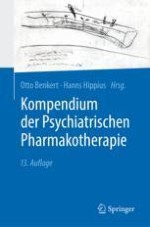2021 | Nichtorganische Schlafstörungen | OriginalPaper | Buchkapitel
5. Medikamente zur Behandlung von Schlafstörungen
verfasst von : Prof. Dr. med. Axel Steiger, Prof. Dr. med. Frank Weber, Otto Benkert
Erschienen in: Kompendium der Psychiatrischen Pharmakotherapie
Verlag: Springer Berlin Heidelberg











